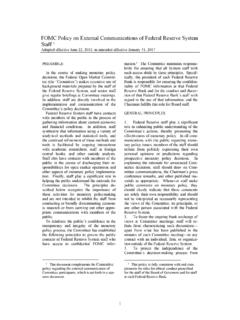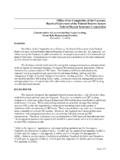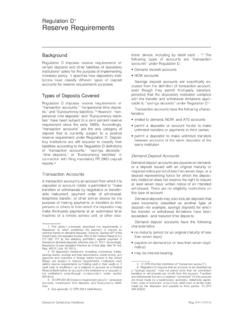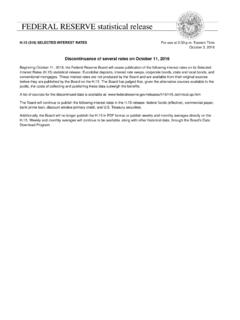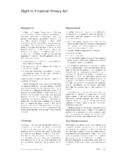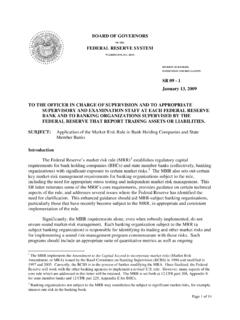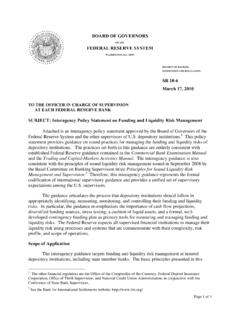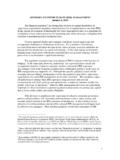Transcription of Attachment to SR 10-6: Interagency Policy Statement on ...
1 Page 1 of 14 Interagency Policy Statement ON funding AND liquidity RISK management March 17, 2010 The Office of the Comptroller of the Currency (OCC), Board of Governors of the Federal Reserve System (FRB), Federal Deposit Insurance Corporation (FDIC), the Office of Thrift Supervision (OTS), and the National Credit Union Administration (NCUA) (collectively, the agencies) in conjunction with the Conference of State Bank Supervisors (CSBS) [Footnote 1 -The various state banking supervisors may implement this Policy Statement through their individual supervisory process. End of Footnote 1.] are issuing this guidance to provide consistent Interagency expectations on sound practices for managing funding and liquidity risk. The guidance summarizes the principles of sound liquidity risk management that the agencies have issued in the past [Footnote 2 -For national banks, see the Comptroller s Handbook on liquidity .]
2 For state member banks and bank holding companies, see the Federal Reserve s Commercial Bank Examination Manual (section 4020), Bank Holding Company Supervision Manual (section 4010), and Trading and Capital Markets Activities Manual (section 2030). For state non-member banks, see the FDIC s Revised Examination Guidance for liquidity and Funds management (Trans. No. 2002-01) (Nov. 19, 2001) as well as Financial Institution Letter 84-2008, liquidity Risk management (August 2008). For savings associations, see the Office of Thrift Supervision s Examination Handbook, section 530, Cash Flow and liquidity management ; and the Holding Companies Handbook, section 600. For federally insured credit unions, see Letter to Credit Unions No. 02-CU-05, Examination Program liquidity Questionnaire (March 2002). Also see Basel Committee on Banking Supervision, Principles for Sound liquidity Risk management and Supervision, (September 2008).
3 End of Footnote 2.] and, where appropriate, harmonizes these principles with the international Statement recently issued by the Basel Committee on Banking Supervision titled Principles for Sound liquidity Risk management and Supervision. [Footnote 3 -Basel Committee on Banking Supervision, Principles for Sound liquidity Risk management and Supervision , September 2008. See Federally insured credit unions are not directly referenced in the principles issued by the Basel Committee. End of Footnote 3.] Recent events illustrate that liquidity risk management at many financial institutions is in need of improvement. Deficiencies include insufficient holdings of liquid assets, funding risky or illiquid asset portfolios with potentially volatile short-term liabilities, and a lack of meaningful cash flow projections and liquidity contingency plans. The following guidance reiterates the process that institutions should follow to appropriately identify, measure, monitor, and control their funding and liquidity risk.
4 In particular, the guidance re-emphasizes the importance of cash flow projections, diversified funding sources, stress testing, a cushion of liquid assets, and a formal well-developed contingency funding plan (CFP) as primary tools for measuring and managing liquidity risk. The agencies expect every depository financial institutions [Footnote 4 -Unless otherwise indicated, this Interagency guidance uses the term depository financial institutions or institutions to include banks, saving associations, and federally insured natural person credit unions. Federally insured credit unions (FICUs) do not have holding company affiliations, and, therefore, references to holding companies contained within this guidance are not applicable to FICUs. End of Footnote 4.] to manage liquidity risk using processes and systems that are commensurate with the institution s complexity, risk profile, and scope of operations.
5 liquidity risk management processes and plans should be well documented [Page Break] Page 2 of 14 and available for supervisory review. Failure to maintain an adequate liquidity risk management process will be considered an unsafe and unsound practice. liquidity and liquidity Risk liquidity is a financial institution s capacity to meet its cash and collateral obligations at a reasonable cost. Maintaining an adequate level of liquidity depends on the institution s ability to efficiently meet both expected and unexpected cash flows and collateral needs without adversely affecting either daily operations or the financial condition of the institution. liquidity risk is the risk that an institution s financial condition or overall safety and soundness is adversely affected by an inability (or perceived inability) to meet its obligations. An institution s obligations, and the funding sources used to meet them, depend significantly on its business mix, balance-sheet structure, and the cash flow profiles of its on- and off-balance-sheet obligations.
6 In managing their cash flows, institutions confront various situations that can give rise to increased liquidity risk. These include funding mismatches, market constraints on the ability to convert assets into cash or in accessing sources of funds ( , market liquidity ), and contingent liquidity events. Changes in economic conditions or exposure to credit, market, operation, legal, and reputation risks also can affect an institution s liquidity risk profile and should be considered in the assessment of liquidity and asset/liability management . Sound Practices of liquidity Risk management An institution s liquidity management process should be sufficient to meet its daily funding needs and cover both expected and unexpected deviations from normal operations. Accordingly, institutions should have a comprehensive management process for identifying, measuring, monitoring, and controlling liquidity risk.
7 Because of the critical importance to the viability of the institution, liquidity risk management should be fully integrated into the institution s risk management processes. Critical elements of sound liquidity risk management include: . Effective corporate governance consisting of oversight by the board of directors and active involvement by management in an institution s control of liquidity risk.. Appropriate strategies, policies, procedures, and limits used to manage and mitigate liquidity risk.. Comprehensive liquidity risk measurement and monitoring systems (including assessments of the current and prospective cash flows or sources and uses of funds) that are commensurate with the complexity and business activities of the institution.. Active management of intraday liquidity and collateral.. An appropriately diverse mix of existing and potential future funding sources.
8 Adequate levels of highly liquid marketable securities free of legal, regulatory, or operational impediments, that can be used to meet liquidity needs in stressful situations.. Comprehensive contingency funding plans (CFPs) that sufficiently address potential adverse liquidity events and emergency cash flow requirements. [Page Break] Page 3 of 14 . Internal controls and internal audit processes sufficient to determine the adequacy of the institution s liquidity risk management process. Supervisors will assess these critical elements in their reviews of an institution s liquidity risk management process in relation to its size, complexity, and scope of operations. Corporate Governance The board of directors is ultimately responsible for the liquidity risk assumed by the institution. As a result, the board should ensure that the institution s liquidity risk tolerance is established and communicated in such a manner that all levels of management clearly understand the institution s approach to managing the trade-offs between liquidity risk and short-term profits.
9 The board of directors or its delegated committee of board members should oversee the establishment and approval of liquidity management strategies, policies and procedures, and review them at least annually. In addition, the board should ensure that it: . Understands the nature of the liquidity risks of its institution and periodically reviews information necessary to maintain this understanding.. Establishes executive-level lines of authority and responsibility for managing the institution s liquidity risk.. Enforces management s duties to identify, measure, monitor, and control liquidity risk.. Understands and periodically reviews the institution s CFPs for handling potential adverse liquidity events.. Understands the liquidity risk profiles of important subsidiaries and affiliates as appropriate. Senior management is responsible for ensuring that board-approved strategies, policies, and procedures for managing liquidity (on both a long-term and day-to-day basis) are appropriately executed within the lines of authority and responsibility designated for managing and controlling liquidity risk.
10 This includes overseeing the development and implementation of appropriate risk measurement and reporting systems, liquid buffers ( , cash, unencumbered marketable securities, and market instruments), CFPs, and an adequate internal control infrastructure. Senior management is also responsible for regularly reporting to the board of directors on the liquidity risk profile of the institution. Senior management should determine the structure, responsibilities, and controls for managing liquidity risk and for overseeing the liquidity positions of the institution. These elements should be clearly documented in liquidity risk policies and procedures. For institutions comprised of multiple entities, such elements should be fully specified and documented in policies for each material legal entity and subsidiary. Senior management should be able to monitor liquidity risks for each entity across the institution on an ongoing basis.


